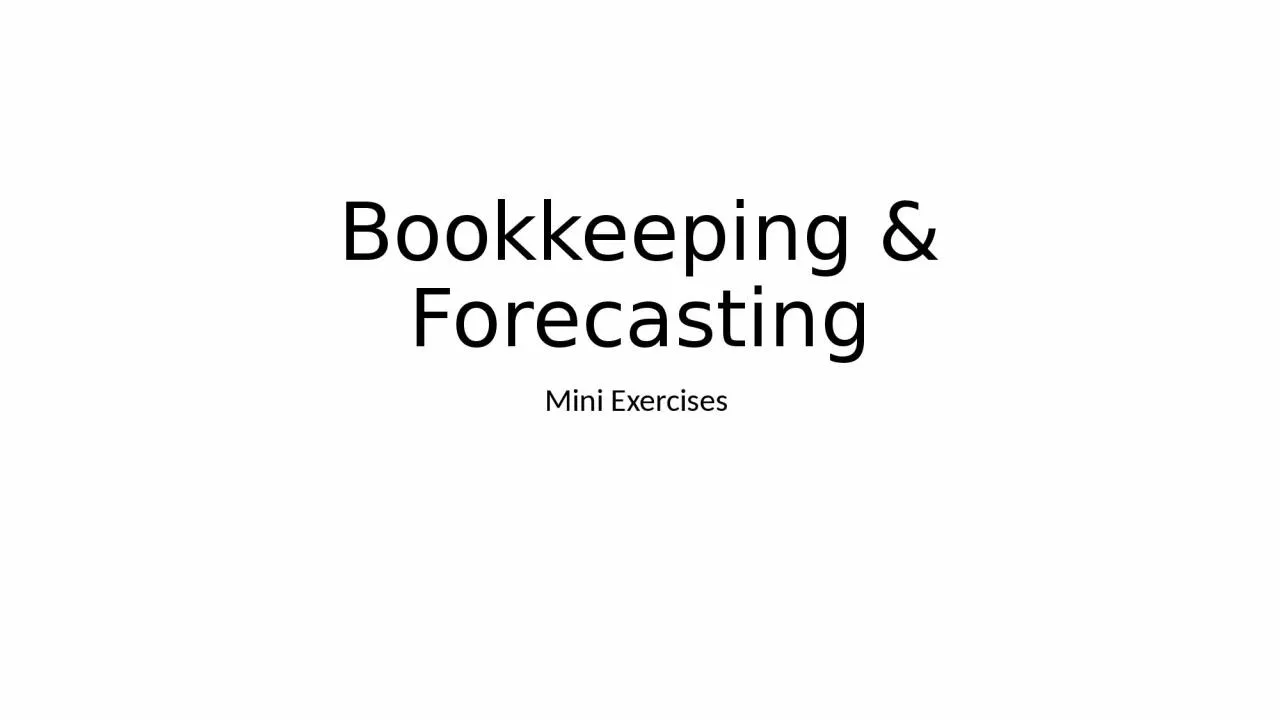

Mini Exercises Common Transactions Common Transactions Model Answer Balance Sheet for a Start Up 12 Balance Sheet for a Start Up 22 Balance Sheet for a Start Up Model Answer ID: 1029792
Download Presentation The PPT/PDF document "Bookkeeping & Forecasting" is the property of its rightful owner. Permission is granted to download and print the materials on this web site for personal, non-commercial use only, and to display it on your personal computer provided you do not modify the materials and that you retain all copyright notices contained in the materials. By downloading content from our website, you accept the terms of this agreement.
1. Bookkeeping & ForecastingMini Exercises
2. Common Transactions
3. Common Transactions (Model Answer)
4. Balance Sheet for a Start Up (1/2)
5. Balance Sheet for a Start Up (2/2)
6. Balance Sheet for a Start Up (Model Answer)
7. Income Statement for a Startup (1/2)
8. Income Statement for a Startup (2/2)
9. Income Statement for a Startup(Model Answer)
10. Gross Profit & Operating Margin (1/2))
11. Gross Profit & Operating Margin (2/2)
12. Gross Profit & Operating Margin(Model Answer)
13. Vertical Analysis
14. Vertical Analysis (Model Answer)
15. Horizontal Analysis
16. Horizontal Analysis Model Answer
17. Analysis Ratio & TrendsScenarioQuestions to ask, trend, ratio, or metric resultRevenue Growth Rate – calculate revenue growth rate from previous quarter for two scenariosa.) Revenue in Q1 was 24,000, in Q2 is 30,000b.) Revenue in Q1 was 24,000, in Q2 is 18,000Gross Profit Margin (Revenue – COGS / Revenue)a.) Cost of Sales in Q1 was 18,000, in Q2 was 26,000b.) Cost of Sales in Q1 was 18,000, in Q2 was 12,000Inventory Turnover (cost of sales/inventory)a.) Average Inventory: Q1 - 12,000, in Q2 - 18,000b.) Average Inventory: Q1 – 12,000, in Q2 – 14,000Cash Ratio (Cash/Current Liabilities a.) End of Q2 Balances: Cash 20,000 Current Liabilities 8,000b.) End of Q2 Balances: Cash 8,000 Current Liabilities 15,000
18. Analysis Ratio & Trends (model answer)ScenarioQuestions to ask, trend, ratio, or metric resultRevenue Growth Rate – calculate revenue growth rate from previous quarter for two scenariosa.) Revenue in Q1 was 24,000, in Q2 is 30,000b.) Revenue in Q1 was 24,000, in Q2 is 18,000Revenue Growth Ratea.) (30-24)/24 = 25% increaseb.) (18-24)/24 = 25% decreaseGross Profit Margin (Revenue – COGS / Revenue)a.) Cost of Sales in Q1 was 18,000, in Q2 was 26,000b.) Cost of Sales in Q1 was 18,000, in Q2 was 12,000Gross Profit Margina.) (24-18)/24 = 25%; (30-26)/30 = 13% decreasingb.) (24-18)/24 = 25%; (18-12)/18 = 33% increasingInventory Turnover (cost of sales/inventory)a.) Average Inventory: Q1 - 12,000, in Q2 - 18,000b.) Average Inventory: Q1 – 12,000, in Q2 – 14,000Inventory Turnovera.) 18/12 = 1.5X; 26/18 = 1.4X b.) 18/12 = 1.5X; 12/14 = 0.9XCash Ratio (Cash/Current Liabilities a.) End of Q2 Balances: Cash 20,000 Current Liabilities 8,000b.) End of Q2 Balances: Cash 8,000 Current Liabilities 15,000Cash Ratioa.) 20/8 = 2.5b.) 8/15 = 0.5
19. Hour 6: Breakeven Analysishttps://www.score.org/resource/break-even-analysis-template